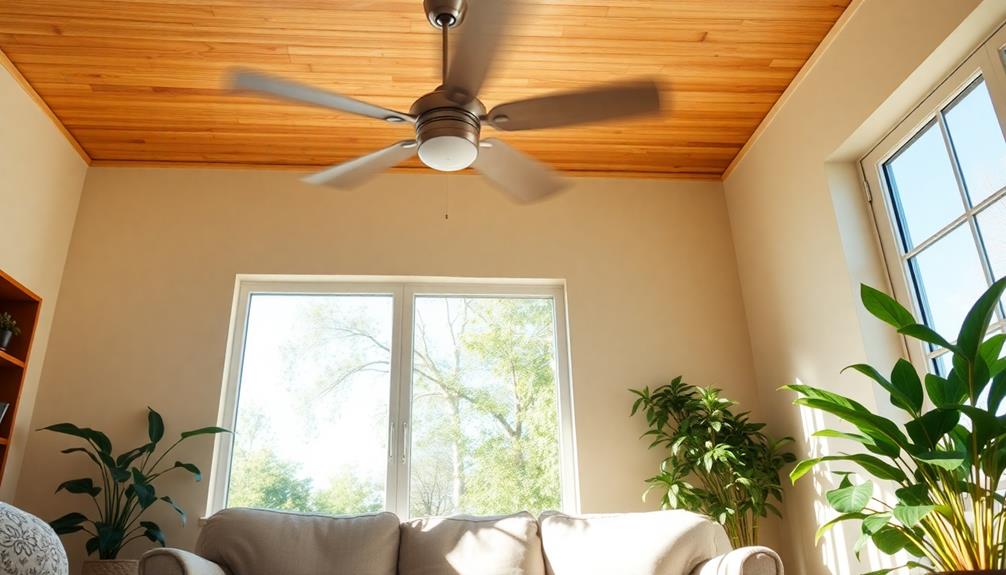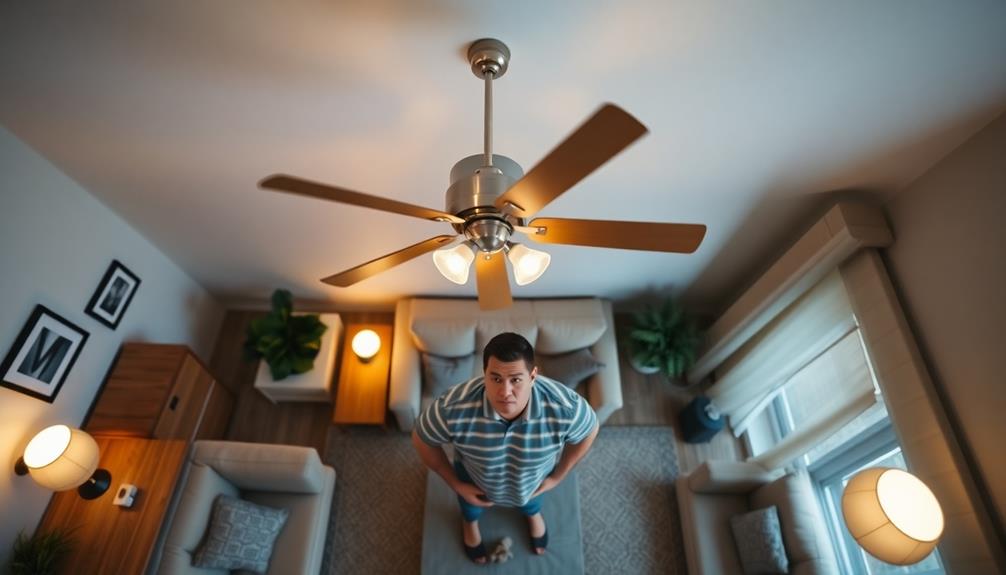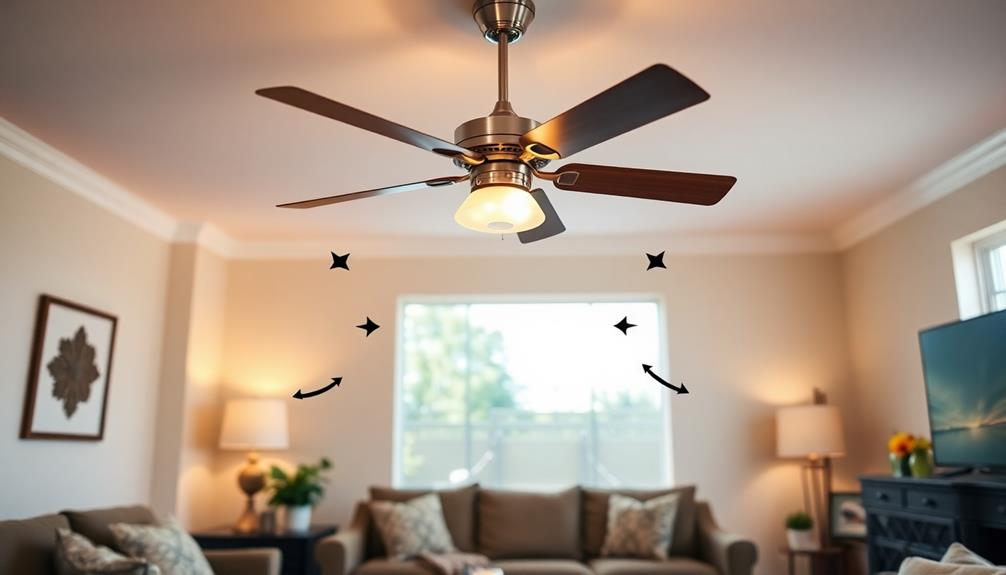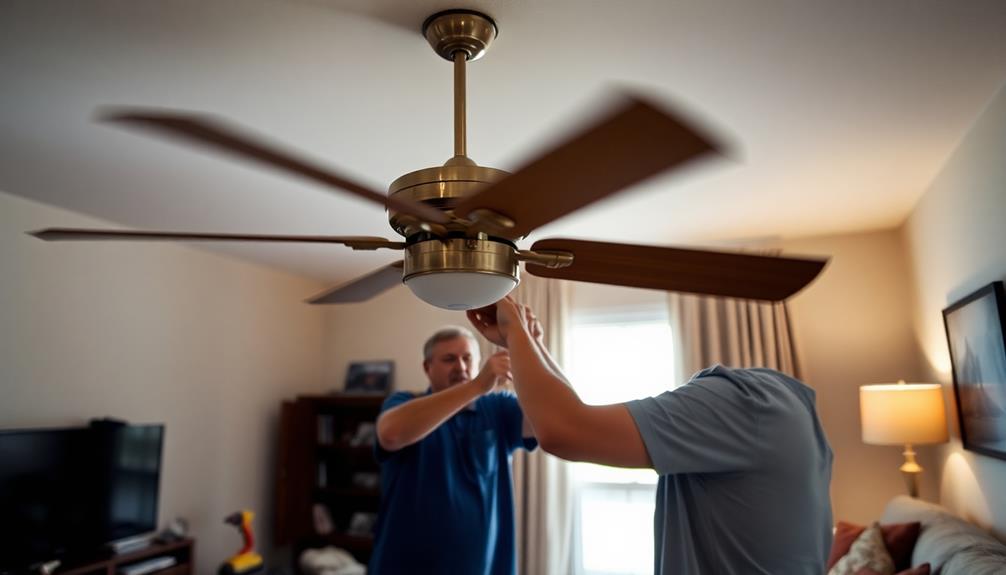If your ceiling fan seems to be spinning backward, it might be time to adjust its direction. A fan spinning counterclockwise creates a cooling breeze in summer, while clockwise circulation helps keep warmth in during winter. Sometimes, misalignment or faulty components cause improper rotation, impacting comfort. To fix this, locate the reverse switch on the motor housing or remote. It's also wise to check the blades for alignment and inspect wiring for any issues. Taking these steps can enhance your comfort and energy efficiency. There's plenty more to learn about optimizing your fan's performance.
Key Takeaways
- Check the fan's direction setting; it should spin counterclockwise in summer and clockwise in winter for optimal airflow.
- Inspect the fan blades for misalignment, which can cause backward spinning and disrupt airflow.
- Look for a reverse switch on the motor housing or remote control to adjust the fan's rotation direction.
- Ensure all wiring connections are secure and check for any loose or damaged wires that may affect operation.
- If issues persist after troubleshooting, consult the fan's manual or contact a professional for assistance.
Understanding Ceiling Fan Directions

Understanding ceiling fan directions is vital for maximizing comfort and energy efficiency in your home. Ceiling fans operate in two main directions: counterclockwise and clockwise.
When your fan spins counterclockwise, it creates a cooling breeze, making summer months feel more comfortable. In contrast, a clockwise spin helps circulate warm air during winter, ensuring your space remains cozy.
This adjustment not only enhances airflow but can also lead to lower energy bills by reducing reliance on air conditioning. The angle of the fan blades also plays a significant role in airflow; steeper angles produce more air movement, which is important for ideal comfort based on room size.
Benefits of Correct Fan Operation

Adjusting your ceiling fan to the correct direction brings multiple benefits that enhance your comfort and energy efficiency. When your fan spins counterclockwise in summer, it creates a wind-chill effect, making the room feel cooler. In winter, a clockwise spin helps circulate warm air, reducing heating costs.
| Benefit | Description |
|---|---|
| Increased Comfort | Creates a cooler environment in summer |
| Energy Efficiency | Allows for higher thermostat settings |
| Prolonged Lifespan | Reduces wear and tear on the fan |
Causes of Backward Fan Spin

A backward-spinning ceiling fan can disrupt your comfort and air distribution in the room. This unusual spin often results from misaligned fan blades or underlying motor issues, like faulty capacitors.
When the blades aren't properly aligned, they can reverse airflow, pushing dust and debris into your space instead of circulating clean air. Additionally, if the motor malfunctions, it might struggle to maintain the correct rotation, causing further inefficiencies.
Such backward spin not only diminishes the fan's effectiveness but can lead to vibrations and increased wear on the motor. To guarantee ideal performance, it's essential to regularly check your fan's alignment and motor condition, addressing any issues before they escalate.
Furthermore, an improperly functioning system can mirror the common causes of heat pump failure, such as mechanical issues and inadequate maintenance, which can lead to decreased efficiency and unexpected breakdowns.
For information on maintaining efficiency, consider exploring energy-saving features.
Troubleshooting Backward Rotation

When your ceiling fan starts spinning backward, it can create an uncomfortable environment and ineffective airflow. This issue can be particularly frustrating, especially if you rely on your fan for cooling during warmer months.
To troubleshoot this issue, follow these steps:
- Locate the Reverse Switch: Check the motor housing or remote control for a switch that changes the spin direction.
- Inspect Fan Blades: Verify that the blades are aligned correctly; misalignment can cause backward spinning.
- Check Wiring Connections: Look for any loose or damaged wires that may be affecting the fan's operation.
- Consult the Manual: Refer to your fan's manual for specific troubleshooting tips or instructions.
If these steps don't resolve the issue, consider contacting a professional to diagnose potential motor problems.
Additionally, understanding the importance of preventive maintenance can help prolong the life of your ceiling fan and prevent future issues.
Adjusting Your Fan Settings

If you've resolved the backward spinning issue, it's time to optimize your fan settings for maximum comfort and efficiency.
Start by turning off the fan and locating the reverse switch on the motor housing or remote. Flip the switch to change the rotation direction.
For summer, set your fan to spin counterclockwise; this creates a cooling breeze, making the room feel up to 4 degrees cooler.
In winter, switch it to clockwise to push warm air down, enhancing warmth without cranking up the heat.
Adjust the fan speed according to your comfort level, utilizing higher speeds for cooling and lower speeds for gentle airflow.
Regularly check your settings to guarantee you're maximizing airflow and energy efficiency year-round.
Safety and Maintenance Tips

Guaranteeing the safety and longevity of your ceiling fan involves regular maintenance and careful operation.
To keep your fan in top shape, follow these essential tips:
- Inspect Regularly: Check for loose screws, worn-out blades, or any unusual noises. Tighten any loose parts to prevent wobbling.
- Clean the Blades: Dust and dirt can accumulate on the blades, affecting performance. Wipe them down monthly with a damp cloth.
- Check Electrical Connections: Confirm all wiring is secure. If you notice any fraying or damage, consult a professional.
- Balance the Fan: If your fan wobbles, use balancing kits to adjust the blades for smooth operation.
Following these tips will help you maintain a safe, efficient ceiling fan for years to come.
Optimizing Comfort Year-Round

Regular maintenance not only keeps your ceiling fan safe but also enhances its performance, allowing you to optimize comfort throughout the year.
To achieve this, adjust your fan's direction seasonally; spin it counterclockwise in summer to create a cooling breeze and clockwise in winter to circulate warm air. This simple switch can make your space feel several degrees more comfortable and reduce energy costs.
Additionally, guarantee the fan blades are clean and properly aligned for effective airflow.
Don't forget to check the fan speed settings; higher speeds provide more cooling, while lower speeds offer gentle airflow.
Frequently Asked Questions
Can a Ceiling Fan Spin in Both Directions Simultaneously?
No, your ceiling fan can't spin in both directions at once. It operates in one direction at a time, either clockwise or counterclockwise, affecting airflow and comfort depending on the season and your needs.
How Can I Tell if My Fan Is Spinning Backward?
As you gaze at your ceiling fan, watch for a gentle breeze against your skin. If it feels warm instead of cool, you might be facing a backward spin—time to check the direction!
Will a Backward-Spinning Fan Increase My Energy Bills?
A backward-spinning fan can increase your energy bills. It won't effectively circulate air, making your space feel less comfortable. You might end up relying more on heating or cooling systems, driving those costs up.
Do All Ceiling Fans Have a Reverse Switch?
Not all ceiling fans have a reverse switch; for instance, a simple model in your living room might lack this feature. Check your fan's manual or housing to confirm if it has one.
Can I Use My Ceiling Fan in Winter?
Yes, you can use your ceiling fan in winter. By reversing its direction to clockwise, it helps distribute warm air, enhancing comfort and reducing heating costs. Just remember to adjust the settings accordingly for maximum efficiency.
Conclusion
Now that you understand the importance of your ceiling fan's direction, you can easily enhance your comfort and energy efficiency. Imagine coming home on a sweltering summer day to a cool breeze from your fan, perfectly set to counterclockwise. You'll feel the difference instantly! By keeping your fan operating correctly, you not only enjoy a cozy atmosphere in winter but also save on energy bills. Take control of your indoor climate and make your space feel just right year-round! Plus, understanding how your fan consumes energy is just as important as setting its direction. With ceiling fan wattage explained, you’ll see how these devices use significantly less energy compared to air conditioners, making them a cost-effective choice for maintaining comfort. By optimizing both direction and energy usage, you can enjoy a perfectly balanced home environment without breaking the bank!










